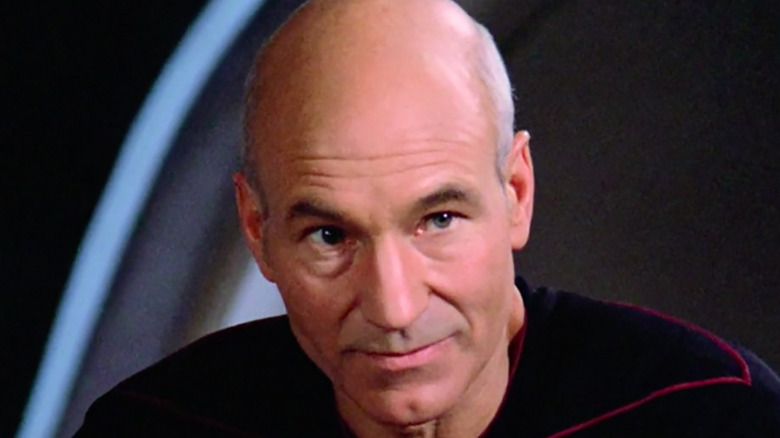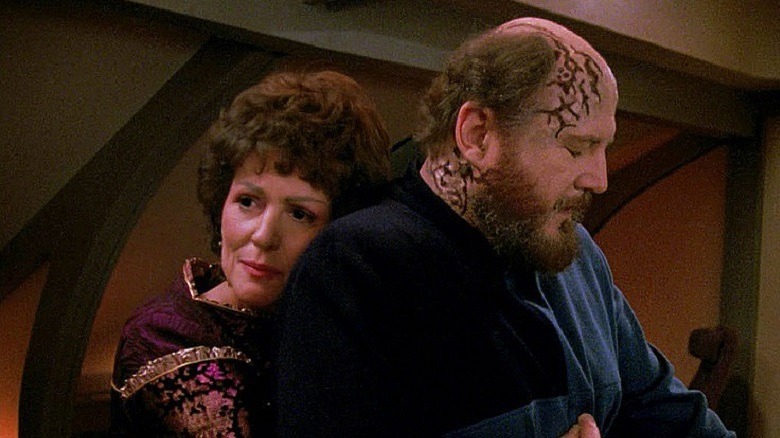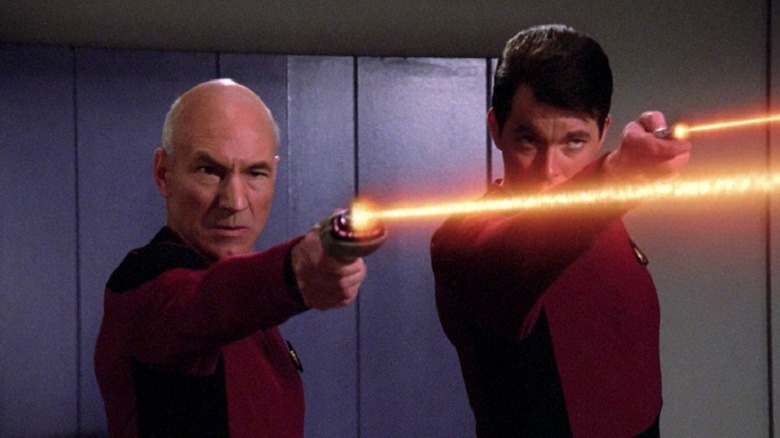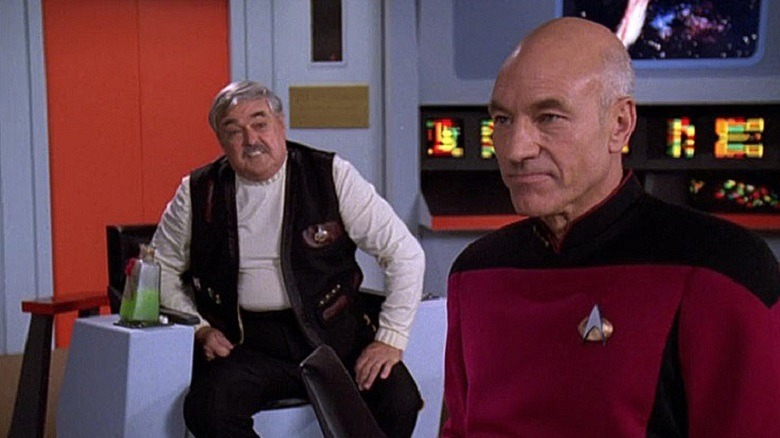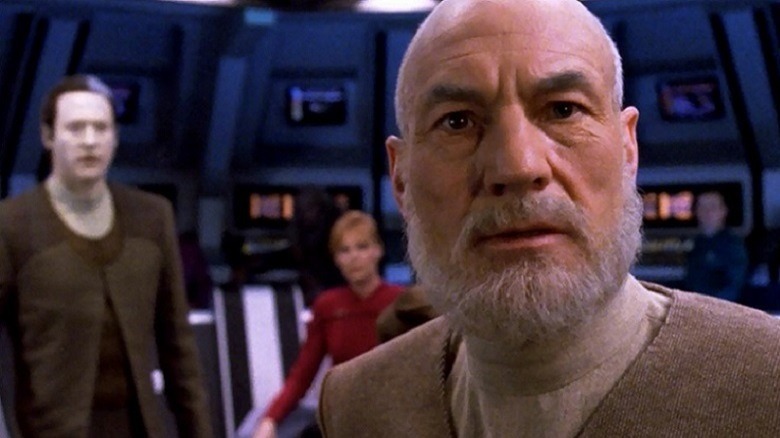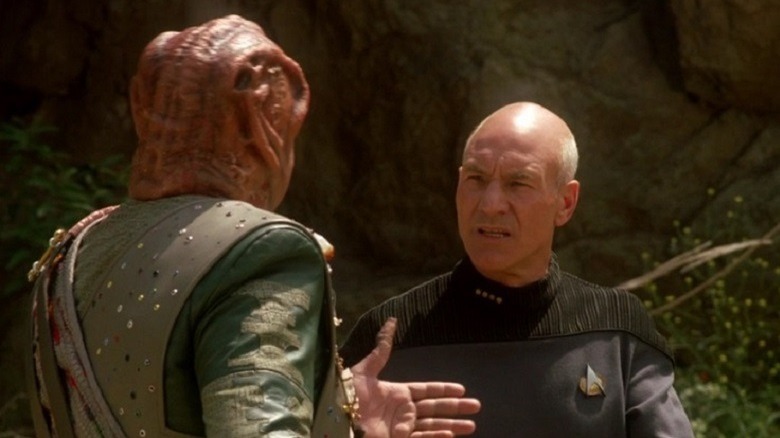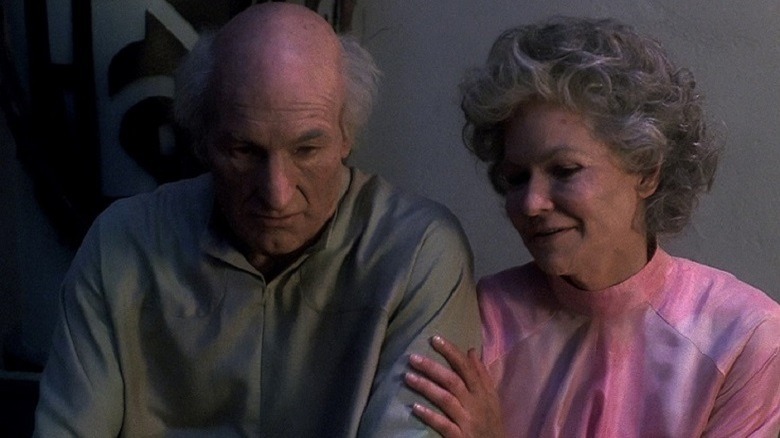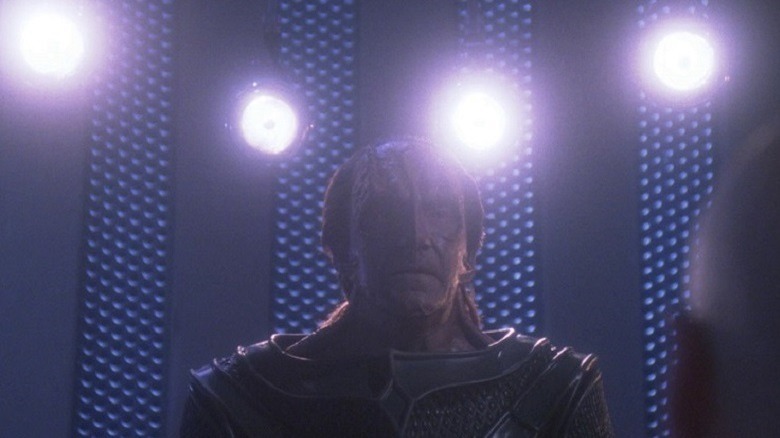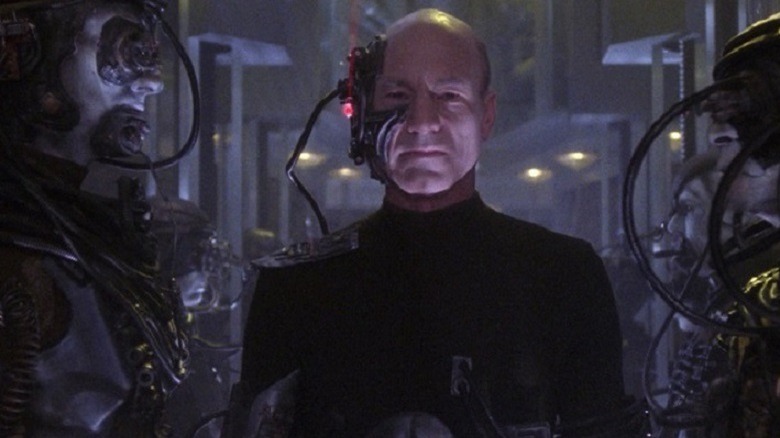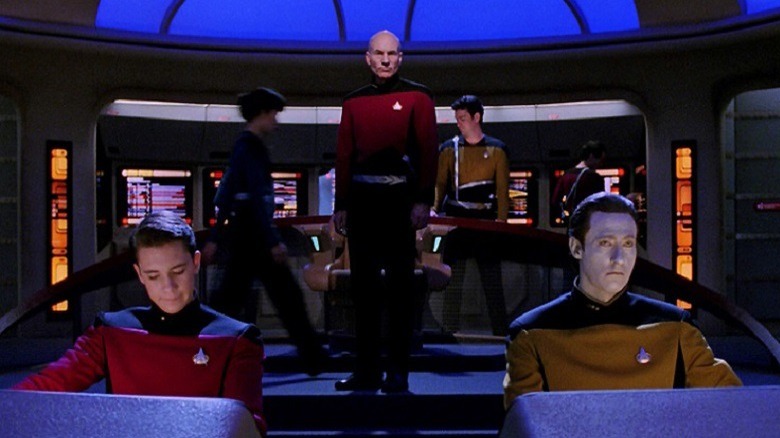Star Trek: The Next Generation's 10 Best Episodes
"Star Trek: The Next Generation" arrived on our screens in September '87, continuing the Enterprise's mission to explore strange new worlds, seek out new life and civilizations, and boldly split infinitives. With a brand new ship, we'd follow the ongoing adventures of an equally fresh-faced crew and its brooding captain across 178 episodes, until the show's finale aired in May '94.
Like any series that exists long enough to breathe and find its place, there were ups and downs. For every "Parallels," there's an "Up the Long Ladder." But there were many highlights, whether found in tales that broke the mold, stories held aloft by excellent performances, or episodes that epitomized the best of the Trek ethos. At its peak, the show was exciting, philosophical, and inspirational.
A word of warning: Boldly, I've dared to feature a Lwaxana Troi episode amongst the highlights. Settle down with your Earl Grey (hot, naturally) and set phasers to "trepidation"...
Half a Life
There's a general unfortunate rule of thumb: The increased presence of Lwaxana Troi in any Star Trek episode is inversely proportional to our enjoyment of said installment. Nothing personal against Majel Barrett-Roddenberry; it's just that Counselor Troi's mother gets under the skin like a Ceti Eel. It could be argued that her character is designed to be annoying. Well then, mission accomplished.
"Half a Life" (Season 4, episode 22) is the exception that proves the rule: a Lwaxana episode approaching brilliance.
The story concerns Timicin, a brilliant scientist (played by David Ogden Stiers, best known as Major Winchester in M*A*S*H) attempting to save his threatened planet from a collapsing sun. His experiments fail, Timicin is devastated, and Lwaxana finds out it is more than the fate of his people that troubles him. He's approaching 60. As is the custom of his society, this reaching this age involves a ritual act of voluntary euthanasia.
Like "Quantum Leap," "The Next Generation" was at its best when it ignored the sci-fi trappings to concentrate on being a storytelling platform. Both series enjoyed the freedom to shake up mood and theme; light-hearted one week, a thought-provoking episode the next, and the best of the "issue" episodes never felt contrived or preachy. "Half a Life" takes a controversial subject — in this case, euthanasia and how a society treats the elderly — and deals with it with respect, care, and thoughtfulness. And the fact that such an episode centers around the normally brash Lwaxana? Nothing short of miraculous.
Conspiracy
"Conspiracy" is an odd beast, falling at the end of Season 1 (Episode 25, just before the execrable clip episode "Shades of Grey") and feeling like it was the precursor to an interesting new direction for Star Trek. Sadly, it never developed outside of DS9 novelizations and the darkest corners of fanfiction. With that in mind, the episode features here as somewhat of an anomaly because of what it could have been, rather than what it was. It felt far different from any Star Trek we'd ever seen.
The treacherous heart of "Conspiracy" begins with Picard beaming alone to a secret meeting between Starfleet Captains, each reporting rumors of strange orders from headquarters. Each expresses concern about a conspiracy growing within Starfleet, which Picard refuses to accept without proof. Later, he learns that his fellow officer's concerns were justified and travels to Earth to expose the plot.
The Federation could be pompous, stubborn, and bureaucratic — and had performed potentially dubious deeds in its time — but up until then had always been shown as a force for good. "Conspiracy," much like the blue-gilled insect creatures that it features heavily, digs into the heart of that, posing a premise that it would have been wonderful to see developed: What if the Federation were the baddies? Sadly, the plotline was resolved in a single episode. A final scene indicating that the conspirators' plot lived on piqued interest, but ultimately came to naught.
Q-Who
Despite the joy of watching two great Shakespearian actors verbally sparring, episodes featuring the omnipotent hyper-braggart Q can be a mixed bag. Plotlines with the immortal pest tend to veer towards the humorous, with Q's God-like powers removing tension from any encounter. He likes Picard and his crew too much to cause any real lasting damage. "Q-Who" (Season 2, Episode 16) is the first Q episode that features a real threat, the immortal's mood veering between helpful and malicious. Most of Q's dealings with Picard seem to involve teaching humanity a lesson, and this is no exception: Here, that lesson is the "Hill Street Blues" motto, "Let's be careful out there."
The plot is straightforward enough, with Q hurtling the Enterprise into uncharted space. The Enterprise has its first encounter with the Borg, the species that would go on to feature across the entire franchise. Trek would go on to defang the Borg through overuse, but here they were a genuinely terrifying new threat. In this new liberal Star Trek, diplomacy was a common solution, yet here was a species so different that mediation would never be an option.
"Q-Who" also marks the point where Guinan is hinted at as being more than just a mere bartender, something that would continue to be developed in the series and the first "Star Trek: The Next Generation" movie, "Generations." The final scene with Guinan and Picard, during which the dread realization dawns that the Borg are now aware of humanity's existence, is both unsettling and prescient.
Relics
We'd had Classic Trek alumni appear on "The Next Generation" before: a bizarre cameo from DeForest Kelley and both Mark Lenard and Leonard Nimoy as Sarek and Spock, respectively. But it wasn't "Relics" (Season 6, Episode 4) that the beloved Montgomery Scott met up with the next generation. The Enterprise, responding to a distress signal from a vessel lost 75 years previous, encounters a Dyson sphere. Despite being 200,000,000 kilometers in size and difficult to hide, it's the first time that the Federation has encountered one. Crashed on the megastructure's surface is the missing vessel. An away team locates the sole survivor of the crash, Scotty.
Despite his heritage, Scotty's preservation is due to wizardry with a transporter buffer rather than the application of single malt whisky. Until a situation arises that requires his brand of expertise, Scotty increasingly finds himself superfluous to the Enterprise's mission. Despite being rescued, he's just as lost as before.
There's a marvelous exchange between strait-laced Geordi La Forge and the twinkle-eyed highlander, one that elegantly sums up their differing personalities. When Geordi is asked how long a piece of analysis will take, he responds the only way he knows how: honestly. Scotty is incredulous; "Oh laddie. You've a lot to learn if you want people to think of you as a miracle worker!" "Relics" is an unsubtle yet poignant look at aging and a man trying to reassess his place in society, in a show that rarely touches upon interpersonal conflict. Also, from a purely fanboy point of view, seeing a perfectly-rendered set of the classic Enterprise ("no bloody A, B, C or D") bridge is a delight.
All Good Things
It has proven difficult for long-running series to nail the landing. For every "Breaking Bad," there's a "Game of Thrones". It's a tricky tightrope walk — you want to give a satisfactory conclusion, but also one that remains honest to what has happened before. In some cases, you have to write a rushed ending because your series is concluding far sooner than you'd hoped.
By its end, "Star Trek: The Next Generation" had accrued an impressive episode count, and Paramount decided to pull the plug — not because of ratings, but because of plans to move the series to the big screen. That wasn't known to the viewers at the time though, so for many "All Good Things" (Season 7, Episodes 25 and 26) needed to be a fitting farewell to our beloved crew. Luckily, it delivered in spades. A suitably epic feature-length episode hopping between three time periods, "All Good Things" spans the entirety of Picard's career from the moment he joined the Enterprise to his retirement 25 years into the future. Picard finds himself hurtling through time, trying to solve a conundrum placed by a (satisfyingly utilized) Q, who has told the captain that he is responsible for dooming humanity.
"All Good Things" delights in fan-service, seeing our beloved crew in their futures. The threat is of a suitably epic scale, and the resolution is both satisfactory and feels like an appropriate conclusion to the ongoing mission. There's a particularly poignant touch at the very end, where Picard joins his crewmates in one of Riker's regular card games, his first such visit. The more things change, the more they stay the same.
Darmok
There are long established Trek rules: One, despite space being three-dimensional and huge, all craft must meet on the same spatial plane, facing each other. Two, aliens must adhere to the standard humanoid template. Occasional ethereal clouds of energy and-slash-or mist may be permitted. Three, alien languages must follow the standard English pattern, just with different words.
"Darmok" (Season 5, Episode 2) claws its lizard-fingered talons onto this list not purely because of its meme-worthiness (ironic in introducing an alien language that operates like a meme itself) but because it dares to do something different with the Star Trek format. In "Darmok," the Enterprise comes into contact with an orbiting Tamarian alien ship. The Federation had attempted contact with them before, but, even with the Universal Translator, could not understand them. Picard's attempts to communicate with the Tamarians are similarly frustrating, but the captain finds himself transported, along with the Tamarian captain, to the planet's surface.
Reminiscent of the 1985 movie "Enemy Mine", Picard and Dathon are forced to work together to overcome a common foe. What makes a potentially mediocre plot stand out is the nature of the Tamarian language: They communicate solely via allegory, and it is only when Picard realizes this that they can converse effectively enough to cooperate. The alien here, despite its humanoid bipedal form, is made properly alien by deviating from what we expect from Trek. It's often the episodes that dare to take risks that stand out.
Inner Light
"Inner Light" (Season 5, Episode 25) is an enigma. It sums up Trek perfectly, but features few of the trappings you'd expect from the franchise. It's an episode you'd show to somebody to introduce them to Trek, with the disclaimer that "there aren't any other ones quite like this." Yes, "best of" lists are contentious. One man's Krada leg is another man's Voraxna, after all. But there are often elements that transcend that, elevating the source material in a way that surprises everybody. You'd be pushed to find many people who wouldn't have this in their own best episode rankings.
In an inelegant and utterly inadequate synopsis that barely does it justice, "Inner Light" is a story about a dying planet. Keen astronomer Kamin has noticed their sun is dying and tries to warn his planet's leaders, but like Jor-El of Krypton, his concerns are ignored. As time passes, Kamin's planet suffers ecological disasters, and the extinction of all life is inevitable. Without the means to save the populace, his race does all they can to preserve their memory, launching a probe that will tell of their people.
It's Picard who encounters this probe, living the entirety of Kamin's life as minutes pass on the Enterprise. The episode is bottled lightning, a beautiful and poignant tale of legacy. Picard, far from regarding the probe's activities as a violation, sees it as a valuable gift from a long dead civilization. It also grants Picard something that his career in Starfleet denied him: the chance of a family. Only a cynic would see the episode as a very convoluted way to learn the flute.
Chain of Command
"Chain of Command" (Season 6, Episodes 10/11) is a standout for several reasons. One is that it humanizes Picard in the very worst way — by breaking him. Secondly, both the primary plot (detailing Picard's undercover mission and subsequent capture) and secondary (Picard's replacement) are both excellent. Captain Jellico takes over the reins of the Enterprise as Picard departs on a covert mission to destroy a Cardassian biological facility. He's subsequently captured and tortured by the Cardassians in scenes more brutal than you'd expect from primetime television.
God bless David Warner. He has featured in "most genre things you have liked," but remains mostly unrecognized, even by those who have seen his decapitated head spinning around in slow-motion in Richard Donner's 1976 horror flick, "The Omen". He's exemplary in every single role he plays, regardless of the amount of latex he's disguised under. Here, he plays Gul Madred, a Cardassian officer tasked with breaking Picard. The two engage in a battle of wills, and the most memorable moments feature Madred trying to convince the beleaguered captain that there are five lights behind him, and not four. In scenes reminiscent of Winston Smith and his torturer in Orwell's "1984", this ordeal goes beyond torturing for information – the oppressor is attempting to utterly break his victim's will.
Lesser actors would have struggled to pull this off, but as executed, the showoff is a masterclass in tension. Madred isn't an entirely unsympathetic character, which adds a level of depth, and Picard's chilling admission in the closing scenes sends shivers down the spine as effectively as any Cardassian torture device.
The Best of Both Worlds
When "The Best of Both Worlds" aired, the Borg hadn't been seen since Season 2, but they hadn't been resting on their cybernetic laurels. Responding to a distress signal from a distant Federation colony, the Enterprise arrives to discover it gone in a dramatic case of colonist irrigation.
A Borg expert arrives on the Enterprise in the form of Lt. Commander Shelby, and Commander Riker feels threatened by her ambitious nature, as she clearly wants his first officer job. The Enterprise has its second encounter with a Borg Cube, and Picard is captured. That leads to one of the greatest cliff-hangers in television history as a newly Borg-ified Picard, transmitting from the Cube, chillingly introduces himself as Locutus of Borg. And then Riker gives the command to open fire on his old boss.
We live in an era where it's difficult to avoid spoilers. We have the death by a thousand cuts on social media where, even if you avoid straight giveaways, you'll inadvertently piece together plots using the snippets you're drip-fed. Imagine the excitement of having to wait an entire summer for plot resolution. That's something that's been lost in time.
Serving as both finale for Season 3 and premiere for Season 4, "The Best of Both Worlds" achieves perfectly what Trek failed to do with "Conspiracy," picking up a threat previously established and delivering on it. Familiarity has somewhat bred contempt, but the Borg were once terrifying, adding a credible antagonist to Star Trek canon after "The Next Generation" failed miserably with the Ferengi. Taken together, these two episodes are one of the best sci-fi action movies to grace the screen. To resist the absolute excitement of this episode is futile.
Yesterday's Enterprise
No Trek series is immune from time travel shenanigans, which the franchise has executed with varying degrees of success. "Yesterday's Enterprise" (Season 3, episode 15) pulls a convoluted concept off with aplomb, offering an action-heavy episode with surprising depth. In the episode, our valiant crew witness the Enterprise NCC-1701-C emerging from one of those rifts that crop up frequently in Trek, causing a timeline-breaking event that rewrites reality. Our Enterprise is now a battlecruiser, the warm ochres and reds of the bridge replaced with cold blues and harsh lighting. Worf vanishes, replaced by Tasha Yar. This Enterprise is at war with the Klingons, which explains why Troi is also missing – there's not much use for an Empath during an intergalactic conflict ("I feel that they are ... angry").
"Yesterday's Enterprise" offers a healthy element of fan-service, with great potential for a game of "Spot the Difference" as viewers recognize changes to sets and characters. Ultimately, our temporal visitors on the Enterprise-C have to return to when they belong, meaning their certain doom. Loyalty and sacrifice are the themes here, playing on a common Trek trope: doing the right thing, regardless of cost.
Time travel episodes of any sci-fi show are often used as an excuse to reset what has gone before, a tachyon-enriched "It was all a dream" trope. "Yesterday's Enterprise" does the opposite, changing the Trek timeline permanently by having Yar's half-Romulan daughter appear in several episodes. It's an episode so strong that you're prepared to forgive the inevitable plot holes that all time-travel related episodes are guilty of. It's one hell of a ride.
